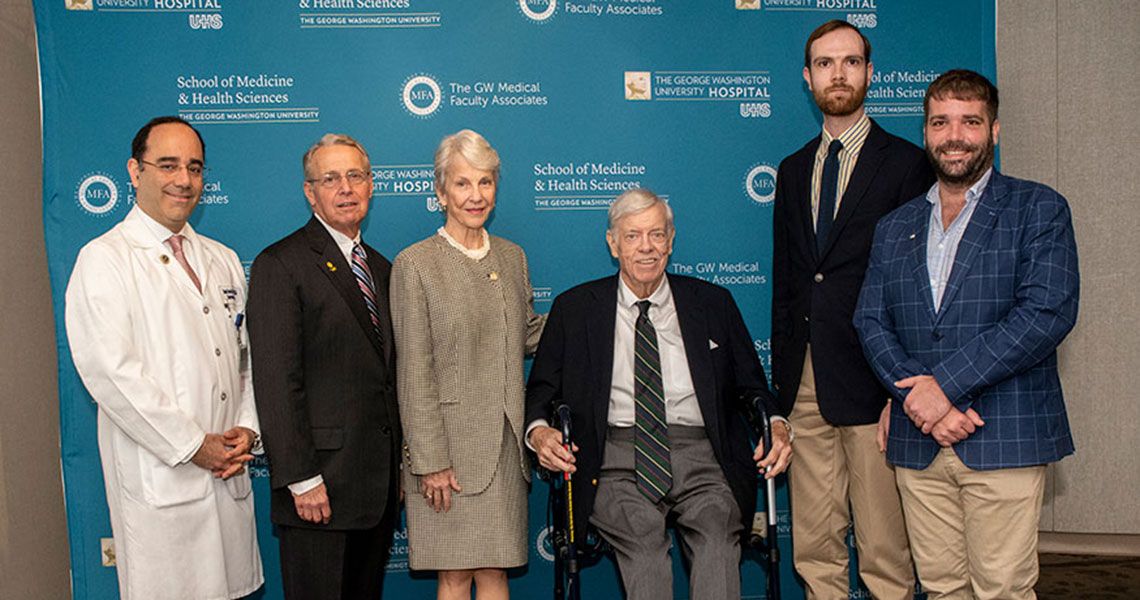In 25 years working at Penn Medicine’s Level 1 Trauma Center, C. William Schwab, MD, said he has seen more than 5,000 gunshot wounds. At the same time, he’s seen great innovation in the field of trauma care. Quoting Charles Dickens, he said “it was the best of times, it was the worst of times.”
Schwab, the founding chief of Penn Medicine’s Trauma Center, was chosen as the first speaker for the inaugural Rosemary and David Bowes Lecture on Trauma and Critical Care. His influence, including shaping GW’s own trauma center, and his vast research experience in the field of gun injury and trauma, said Babak Sarani, MD ’97, RESD ’04, director of the Center for Trauma and Critical Care at the George Washington University (GW) Hospital and professor of surgery and of emergency medicine at the GW School of Medicine and Health Sciences, made Schwab an ideal choice to launch the series.
The newly minted annual lecture, held May 8 in the GW Hospital Auditorium, was endowed by Rosemary Bowes, PhD, assistant clinical professor of psychiatry and behavioral sciences at SMHS, and her husband David Bowes Bigelow, a former journalist, in memory of their grandnephew, Vaughn Scott Bigelow Jr., 13, who was killed by a gunman following a road rage incident in Colorado.
“Vaughn’s memory lives on in this lecture, whose aim is to educate all care providers throughout the region on all aspects of firearm injuries,” Sarani said.
Schwab served 30 years in the Navy, is the founding member of the Eastern Association for the Surgery of Trauma, and has more than 250 research publications on firearm injury prevention to his name.
Throughout his talk, titled “Damage Control and Firearm Death: A Tale of Two Cities,” Schwab spoke about both his experience handling trauma in Philadelphia, and traced the advances and setbacks in the care of gun injuries in America.
Schwab started his talk with the 1960s, when the escalation and availability of handguns began to change inner city crime and leave law enforcement with questions they couldn’t answer, he said. But as the United States entered the 1970s and the Vietnam War wound down, a large influx of doctors, nurses, and other health professionals returned to civilian medical centers; professionals who had first-hand experience with major trauma situations.
“There was a tremendous need to compare outcomes in medical care with wounds on the battlefield to that in the streets of America,” Schwab said.
Those changes, he added, helped revolutionize trauma care, including directing patients not to the closest hospital, but to hospitals with certified trauma centers. These were glimmers of hope, he said.
Amid the hope, however, there still was darkness. Schwab was recruited to Penn in 1987, and in one year he saw 525 gunshot cases. Surgeons, he said, always have had to innovate at the table, and this was no different. New ways of treating patients with gunshot wounds were looked at because often the standard definitive surgery didn’t work, he said.
“It seemed to be that we had stumbled on the age of wisdom and for a moment what we saw [was] a spring of hope,” he said.
There was still pain, though, he added. “It is hard to describe death. … It is hard, painful, and renders most surgeons speechless. A death on the operating table never leaves you. I struggled with this, with the loss,” he said.
Then, in the 1980s, gun violence research started to grow. “It was a new era. Some very, very smart people very quietly had started funding research to look at big picture items about quantifying and even qualifying gun violence in America; it had not been done before.”
In 1991, the editor of the Journal of the American Medical Association (JAMA) called for all JAMA-related publications to print an article on firearm violence in America in a year. “They were overwhelmed with submissions, they could not accept them all,” Schwab said. Then, in June 1992, those articles were published, ones on high death rates among urban teenagers, guns in family assault, studies on handgun safety and access, and more. “Violence was finally called a public health emergency,” he said.
Another small glimmer of hope came in 1993, he continued, when criminology and law enforcement officials embraced public health and medicine as partners to start to look at the problem in an interdisciplinary way. “It doesn’t sound like much, but let me tell you: There’s power in the team, there’s power in the group,” he said.
An increase in this research marked a turn in Schwab’s career. He didn’t know that much about research, so he relied on others. “It’s all about partnerships and all about a great institution like this one that I’m speaking at today.”
At the end of his presentation, on the screen at the front of the room, Schwab showed a photo of GW SMHS students standing together supporting SAFE, or Scrubs Addressing the Firearm Epidemic.
“It is the youth sitting in front of me that are the future and the hope,” he said.



